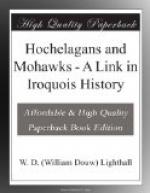It is noticeable that the earliest accounts of the Five Nations speak of them as of two kinds—Mohawks and “Sinnekes,” or as termed by the French the Inferior and Superior Iroquois. For example Antony Van Corlear’s Journal, edited by Gen. James Grant Wilson, also certain of the New York documents. The most thorough local student of early Mohawk town-sites, Mr. S.L. Frey, of Palatine Bridge, N.Y., supports Mr. Beauchamp in his view of the late coming of the Mohawks into the Mohawk River Valley, where they have always been settled in historic times. According to him, although these people changed their sites every 25 or 30 years from failure of the wood supply and other causes, only four prehistoric sites have been discovered in that district, all the others containing relics of European origin. Mr. Beauchamp believes even this number too large. Both put forward the idea that the Mohawks were the ancient race of Hochelaga, whose town on the island of Montreal was visited by Jacques Cartier in 1535, and had disappeared completely in 1608 when Champlain founded Quebec. “What had become of these people?” writes Mr. Frey, in his pamphlet “The Mohawks.” “An overwhelming force of wandering Algonquins had destroyed their towns. To what new land had they gone? I think we shall find them seated in the impregnable strongholds among the hills and in the dense forests of the Mohawk Valley.”
It is my privilege to take up their theory from the Montreal end and in the light of the local archaeology of this place and of early French historical lore, to supply links which seem to throw considerable light on the problem.
The description given by Cartier of the picturesque palisaded town of Hochelaga, situated near the foot of Mount Royal, surrounded by cornfields, has frequently been quoted. But other points of Cartier’s narrative, concerning the numbers and relations of the population, have scarcely been studied. Let us examine this phase of it. During his first voyage in 1534, in the neighbourhood of Gaspe, he met on the water the first people speaking the tongue of this race, a temporary fishing community of over 200 souls, men, women and children, in some 40 canoes, under which they slept, having evidently no village there, but belonging, as afterwards is stated, to Stadacona. He seized and carried to France two




